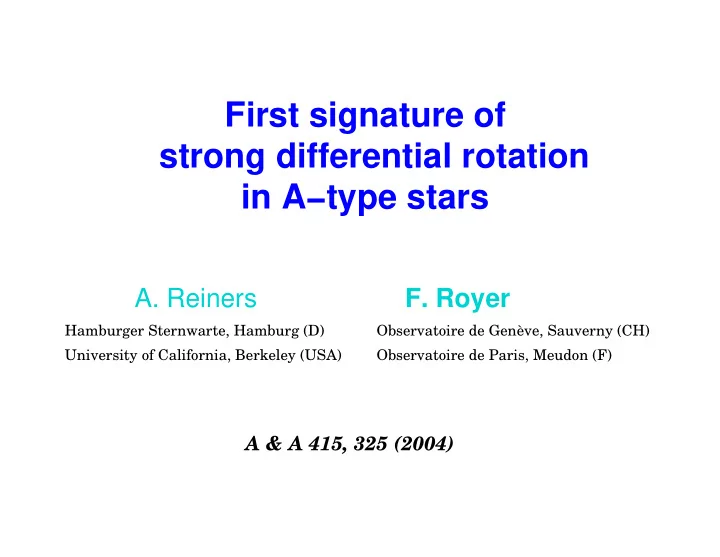

First signature of strong differential rotation in A−type stars A. Reiners F. Royer Hamburger Sternwarte, Hamburg (D) Observatoire de Genève, Sauverny (CH) University of California, Berkeley (USA) Observatoire de Paris, Meudon (F) A & A 415, 325 (2004)
Context stars of spectral type earlier than F2 no or very thin convective envelopes between A7 and F5 onset of convection ? Wolff et al. (1986), Schmitt (1997), Renzini et al. (1977), Gray & Nagel (1989) coupling between convection and differential rotation ? no indication of differential rotation in A−type stars Gray (1977) Reiners & Schmitt (2003) differential rotation in F−type stars (as early as F0)
Observational material Echelec spectra (ESO, La Silla) 4210 − 4500 Å R ~ 28000 ~ 500 stars, spectral types B8−F2 Determination of radial velocities: Grenier et al. (1999) Determination of rotational velocities: Royer, Gerbaldi et al. (2002)
v sin i determination Royer, Gerbaldi et al. (2002) Fourier Transform (FT) of line profiles 15 candidate lines a priori selection (spectral type, broadening) and a posteriori (FT) q 1 precision ~6 % poster BP1
Detection of differential rotation Reiners & Schmitt (2002) Use of the first two zeroes of the FT: and q 1 q 2 ratio can be used as a signature q 2 /q 1 α of differential rotation solar−like differential rotation 2 Ω( ) = Ω equator α l (1 − sin ) l
Data analysis Sample: 158 A0−F1 stars (follow the FT to the second zero) 60 < v sin i < 150 km/s Least Square Deconvolution δ− template from the150 strongest lines (VALD) deconvolution: broadening function few iterations adjustment of equivalent widths use of every lines, enhancement of SNR Fourier Transform of the broadening function
Results could be determined q /q 1 2 for 78 stars v sin i = 0.99 (±0.05) v sin i RGFG − 1.6 (±4.6)
Results ε Linear limb darkening law, from 0.5 to 0.75 ∆ q 2 /q 1 ~ 0.1 Rigid rotation expected for between 1.72 and 1.83 q 2 /q 1
Candidate stars α Type v i sin q /q v i 2 1 e A9 V HD 6869 100 ± 6 1.55 ± 0.08 0.28 ± 0.10 460 13° A6 V HD 60555 115 ± 7 1.54 ± 0.07 0.29 ± 0.08 470 14° F0 IV/V HD 109238 103 ± 4 1.51 ± 0.11 0.32 ± 0.13 500 13° A9/F0 IV HD 44892 152 ± 5 1.64 ± 0.10 0.16 ± 0.16 400 22° extremely fast rotation ? also affected by very rapid rotation and gravity darkening q /q 2 1 only depends on equatorial velocity q /q v e (Reiners 2003) 2 1 HD 44892 also consistent with gravity darkening effect binarity ? no signature in spectra nor in FTs
Fourier Transforms of HD 6869, 60555 and 109238 No evidence of binarity in the FT
Conclusions 158 A0−F1 stars 60 < sin < 150 km/s v i 78 stars with measurable q /q 2 1 4 stars with signature of differential rotation (1 marginal) in these objects: equator rotates ~30% faster than pole Altair high SNR observations no evidence of differential rotation gravity darkening effect: determination of i
Recommend
More recommend